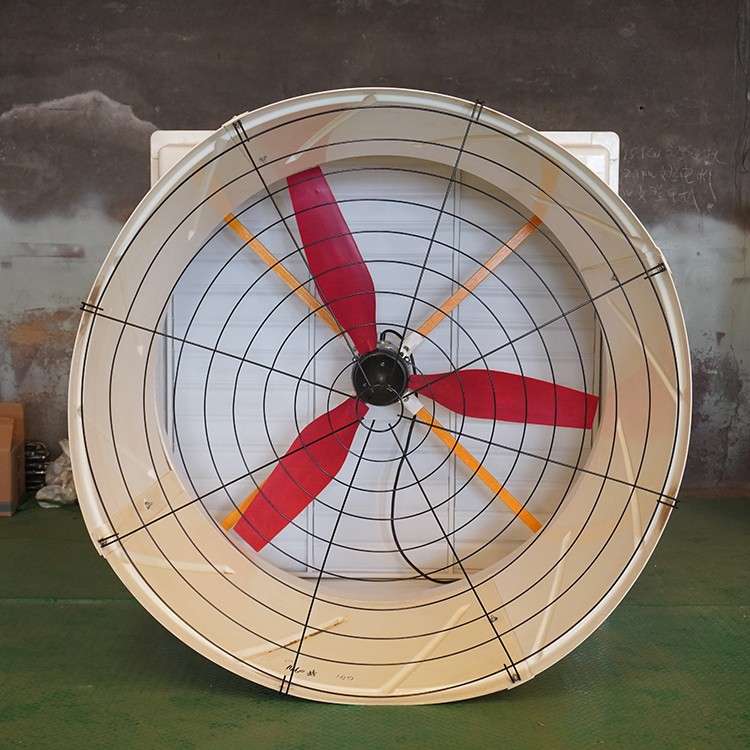Introducción
The agricultural sector heavily relies on maintaining optimal conditions within barns and structures to ensure the well-being of livestock and the preservation of agricultural produce. A critical component in achieving these conditions is the efficient management of air quality and ventilation farm. Barn exhaust fans stand as vital elements in this regard, playing a significant role in enhancing air circulation and quality within agricultural facilities.

Understanding the Need for Air Quality Improvement in Agricultural Structures
Agricultural structures often face challenges related to air quality, stemming from factors such as moisture, dust, ammonia, and pathogens. These elements, if left unmanaged, can result in adverse consequences for both livestock and agricultural produce. Poor air quality poses threats to animal health, such as respiratory issues and stress, while also affecting the quality and shelf life of crops or stored goods.
Functionality and Mechanism of Barn Exhaust Fans
Barn exhaust fans are designed to facilitate air exchange within agricultural structures. These fans operate by expelling stale air laden with contaminants and drawing in fresh air from the outside. Various types and sizes of barn exhaust fans are available to suit the diverse needs of different agricultural facilities, considering factors like barn size, layout, and the specific requirements of the livestock or stored produce.
Contributions of Barn Exhaust Fans to Air Quality Improvement
The installation of barn exhaust fans offers multifaceted benefits, chiefly in the removal of airborne contaminants that could compromise the health of livestock or degrade agricultural produce. These fans efficiently remove dust particles, mold spores, and gases like ammonia, thereby significantly improving air quality. Additionally, they aid in controlling humidity levels, preventing moisture buildup and creating a healthier environment.
Impact on Livestock Health and Agricultural Produce
Improved air quality resulting from the use of barn exhaust fans directly correlates with better livestock health. Livestock housed in well-ventilated barns experience reduced respiratory stress, contributing to improved growth rates, reproductive performance, and overall well-being. Similarly, controlled ventilation farm positively impacts the quality and shelf life of agricultural produce, minimizing spoilage and preserving freshness.
Energy Efficiency and Sustainability Aspects
Modern barn exhaust fans often integrate energy-efficient features and technologies, ensuring optimal ventilation farm while minimizing energy consumption. The utilization of sustainable ventilation farm systems not only reduces operational costs but also aligns with environmentally friendly practices, contributing to a greener and more sustainable agricultural industry.
Best Practices and Maintenance of Barn Exhaust Fans
Proper installation and routine maintenance of barn exhaust fans are critical for their optimal performance. Strategic placement of fans to ensure uniform airflow, coupled with regular checks and cleaning, ensures their efficiency and longevity. Compliance with safety standards and regulations is imperative to guarantee safe operations within agricultural facilities.
Casos prácticos o ejemplos
Several real-world instances highlight the tangible benefits of employing barn exhaust fans in agricultural settings. Farm X, for instance, observed a notable decrease in respiratory issues among their livestock merely months after integrating an advanced ventilation farm system. This improvement correlated with an increase in milk production, signaling a positive shift in overall farm output. Similarly, testimonials from various farmers underscore the transformative effects of barn exhaust fans in creating healthier livestock environments and preserving the quality of stored agricultural goods.
Conclusión
In summary, barn exhaust fans are indispensable components in agricultural ventilation farm systems, significantly contributing to enhanced air quality and ventilation farm within agricultural structures. These fans play a crucial role in mitigating the detrimental effects of poor air circulation and contamination within barns, directly impacting livestock health and the preservation of agricultural produce.
Understanding the imperative nature of maintaining optimal air quality in barns leads to acknowledging the pivotal role of barn exhaust fans. These fans effectively remove airborne contaminants, regulate humidity, and promote adequate air circulation, ensuring a conducive environment for livestock and agricultural goods.
Moreover, as the agricultural industry evolves, the integration of energy-efficient and sustainable barn exhaust fans marks a proactive approach toward reducing environmental impact while maximizing operational efficiency. The utilization of modern technologies not only ensures better air quality but also aligns agricultural practices with environmentally conscious standards.
Implementing best practices, such as proper installation, routine maintenance, and adherence to safety regulations, ensures the seamless functionality of barn exhaust fans. This, in turn, guarantees their effectiveness in improving air quality and ventilation farm, fostering healthier livestock and maintaining the integrity of agricultural products.
In conclusion, barn exhaust fans stand as essential assets in modern agricultural practices, serving as guardians of air quality and ventilation farm within barns. Their impact reverberates through improved livestock health, increased agricultural productivity, and sustainability in farming operations. As the agricultural sector continues to prioritize animal welfare and sustainability, barn exhaust fans remain integral in shaping a healthier and more efficient future for agricultural environments.
Productos relacionados





